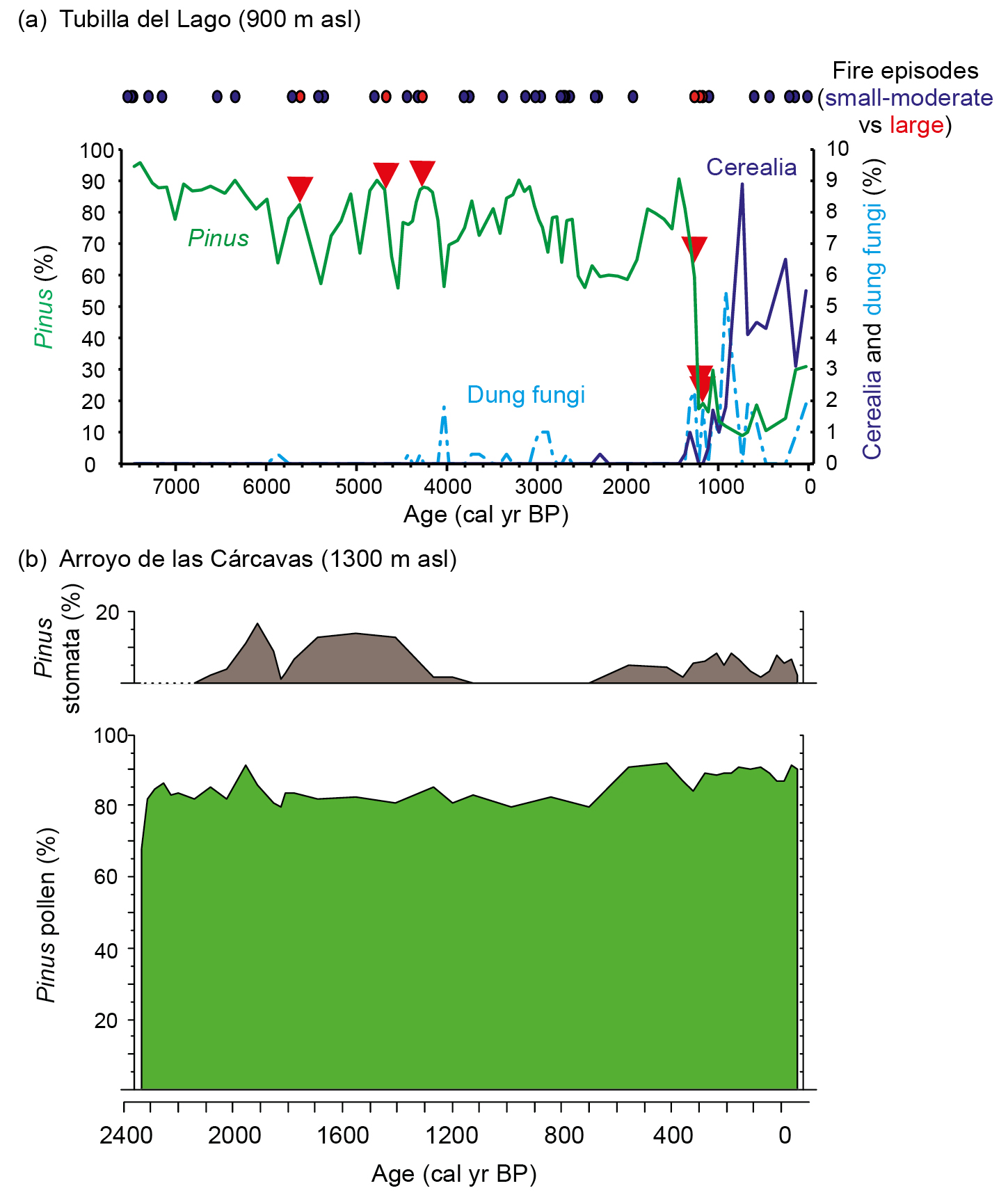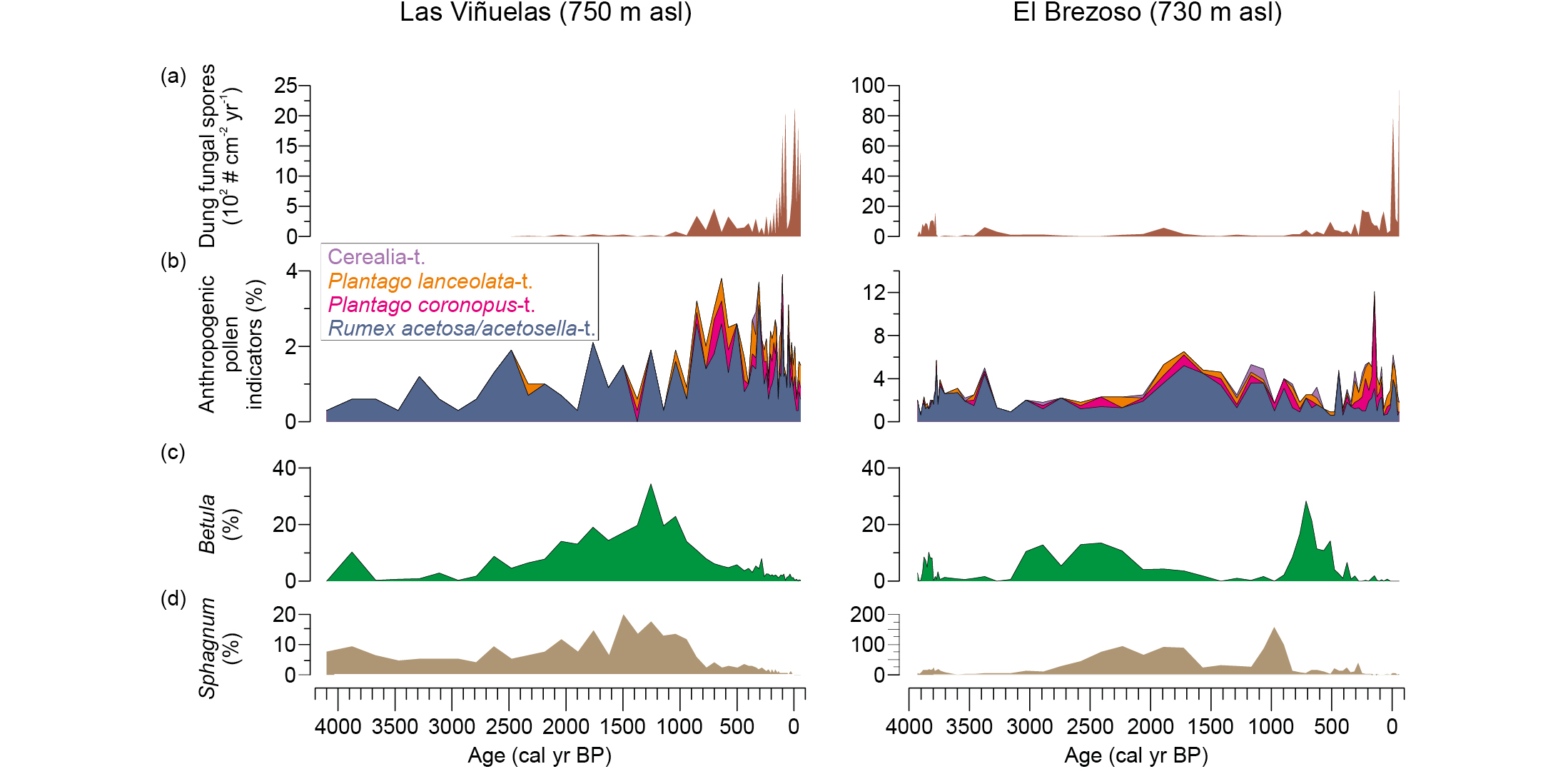- Home
- Publications
- PAGES Magazine
- Paleoecology-guided Ecosystem Management and Restoration In The Western Mediterranean
Paleoecology-guided ecosystem management and restoration in the Western Mediterranean
Morales-Molino C and Schwörer C
Past Global Changes Magazine
30(1)
6-7
2022
Drawing on several case studies from the Iberian Peninsula, we show how specifically designed paleoecological research can be a useful tool to guide ecosystem management, conservation, and restoration.
The Mediterranean region is well known for its outstanding diversity of species and ecosystems. This natural heritage is, nevertheless, threatened not only by ongoing climatic change, but also by legacies of multi-millennial land use and shifts in land-use patterns, which can significantly alter natural disturbance regimes. This raises questions for management and restoration of ecosystems that can be informed by long-term data from paleoecology. Here, we discuss three examples from the Iberian Peninsula that relate to fire management, herbivore management, and the conservation of cultural landscapes.
Changing fire regimes and their impact on Pinus nigra forests
Depopulation of rural areas and abandonment of traditional farming practices are currently leading to increased woodland encroachment, and subsequent accumulation of dead biomass (Keeley et al. 2012). Under particularly favorable conditions for fire spread and the presence of (usually anthropogenic) ignition sources, these landscapes offer the perfect setting for catastrophic fires. Concerned by this relevant and increasingly pressing issue, ecosystem managers often try to adapt forest management strategies to prevent these large and severe fires, or at least limit their spread.
In the Northern Iberian Plateau (central-northern Spain), we investigated the causes of the regional demise of Pinus nigra forests during historical times using a multi-proxy approach including pollen, conifer stomata, dung fungal spores, and charcoal particles, alongside peak detection analysis (Morales-Molino et al. 2017a). The results show that pine forests were the dominant vegetation in the region for most of the Holocene, under a mixed fire regime consisting of frequent low-severity (ground) fires and rare high-severity (crown) fires (Fig. 1). Consistent with its life-history traits (Tapias et al. 2004), P. nigra was able to resist ground fires but, unexpectedly, stands could also recover after single crown fires despite lacking specific adaptations (e.g. serotinous cones). However, when crown fires became very frequent with the intensification of arable and pastoral farming during the Middle Ages (1200–1000 yr cal BP), pine forests rapidly declined and even disappeared regionally (Fig. 1a).
The take-home message for forest managers who want to preserve the species-rich Pinus nigra forests currently thriving in the circum-Mediterranean mountains is that fuel loads need to be managed using prescribed ground fires, in order to prevent high-severity crown fires. This low-severity fire regime will, in turn, also promote seedling recruitment.
Unprecedented herbivore densities and the fate of Mediterranean mires
Another worrying aspect of ongoing land abandonment, in combination with the local extirpation of natural predators, is the dramatic increase in the densities of wild ungulates that prevents the recruitment of palatable woody species and causes potentially damaging disturbance when large herds visit wetlands (e.g. mires, springs, ponds) during the dry Mediterranean summers. Managers of protected areas need scientific knowledge about the carrying capacity of these ecosystems, i.e. the herbivore densities that the ecosystem can tolerate without risking its functionality.
In the Cabañeros National Park (central-southern Spain), current densities of wild ungulates (e.g. red deer, wild boar) are so high that mires are regularly damaged, and tree regeneration is seriously affected. We conducted paleoecological research on two peat sequences to investigate the past impact of herbivore densities (wild ungulates and livestock), inferred from dung fungal spores (Baker et al. 2016), and land use on the mires of this protected area (Morales-Molino et al. 2019). The pollen and dung fungal spore data show that locally growing Betula stands, as well as Sphagnum mats, declined and even went extinct when pastoral farming increased during the Middle Ages (1000–800 yr cal BP; Fig. 2). The influxes of dung fungal spores suggest that the extremely high current herbivore densities are unprecedented in the context of the past 4000 years. Therefore, herbivores pose a severe threat to extant mires in the region, including those where relict birch stands still survive. We strongly recommend fencing the mires to prevent further destruction by ungulates, as well as controlling the populations of these herbivores, preferably by the re-introduction of natural predators such as wolf or Iberian lynx, which went regionally extinct just a few decades ago.
What is "natural" in the Mediterranean region?
The millennial history of farming and forest use in the Mediterranean region makes it hard to assess the naturalness of certain ecosystems often considered as purely anthropogenic based on a shorter-term perspective. Precise knowledge about the "natural" composition and structure of vegetation is of paramount importance if the goal is to restore ecosystems to their "original" state, preceding the onset of heavy human impact.
The question of what the natural vegetation in an area would be remains crucial in many Mediterranean areas that were intensively disturbed by land use in the past. The "potential natural vegetation" concept, i.e. mature vegetation in the absence of human impact, has been widely used during the past few decades in this context, despite being subject to debate and controversy (e.g. Carrión and Fernández 2009; Chiarucci et al. 2010; Farris et al. 2010; Loidi and Fernández-González 2012). The long-term empirical perspective of paleoecology on vegetation dynamics, in particular in response to human impacts, allows a largely refined discussion of this topic (e.g. Carrión and Fernández 2009).
In the Valsaín forests of the Sierra de Guadarrama National Park, in the Iberian Central Range, the potential natural vegetation would consist of Quercus pyrenaica forests, whereas pine forests are thought to have been favored by humans (Morales-Molino et al. 2017b). We analyzed several mires using a multi-proxy approach (pollen, conifer stomata, plant macrofossils) to investigate whether Pinus sylvestris forests occur naturally at relatively low elevation in these mountains. The high pollen percentages along with the finds of Pinus stomata and macrofossils demonstrate that Scots pine has dominated forests as low as 1300 m asl for at least the past 2500 years (Fig. 1b). Paleoecological evidence therefore supports the naturalness of pine forests and refutes the need to favor Quercus pyrenaica in forest management.
Conclusions and outlook
The three case studies presented above illustrate how paleoecological data provide relevant information to guide the conservation and restoration of Mediterranean ecosystems. The first two examples show how paleoecological records can assist in restoring fire regimes and herbivore densities that maintain and recover vegetation. The third example shows how the long-term perspective provided by paleoecology, particularly with respect to past human impacts on vegetation dynamics, can help resolve some of the controversies raised by the "potential natural vegetation" concept (e.g. Carrión and Fernández 2009). However, we acknowledge the need for refinements and novel techniques for a broader use of these data in a global change scenario.
For instance, dynamic vegetation models allow us to disentangle the past roles of climate, disturbance, and human activities in driving vegetation changes, improving predictions of future vegetation dynamics under different scenarios of climate change and land use (e.g. Henne et al. 2015; Schwörer et al. 2014). Additionally, population genetic analyses on ancient DNA preserved in plant macrofossils may provide unique information on which variant of a given tree species would be best suited to revive a population that became locally extinct in the past (Schmid et al. 2017).
affiliation
Institute of Plant Sciences and Oeschger Centre for Climate Change Research, University of Bern, Switzerland
contact
César Morales-Molino: cesar.morales ips.unibe.ch; cesarmoralesdelmolino
ips.unibe.ch; cesarmoralesdelmolino gmail.com
gmail.com
references
Baker AG et al. (2016) Methods Ecol Evol 7: 1273-1281
Carrión JS, Fernández S (2009) J Biogeog 36: 2202-2203
Chiarucci A et al. (2010) J Veg Sci 21: 1172-1178
Farris E et al. (2010) J Biogeog 37: 2211-2213
Henne PD et al. (2015) Front Ecol Environ 13: 356-362
Higuera PE et al. (2009) Ecol Monogr 79: 201-219
Loidi J, Fernández-González F (2012) J Veg Sci 23: 596-604
Morales-Molino C et al. (2017a) J Ecol 105: 634-646
Morales-Molino C et al. (2017b) Glob Planet Change 152: 64-75
Morales-Molino C et al. (2019) Ecology 100: e02833
Perea R, Gil L (2014) For Ecol Manag 312: 47-54
Schmid S et al. (2017) Methods Ecol Evol 8: 1374-1388

